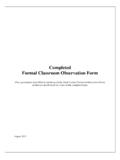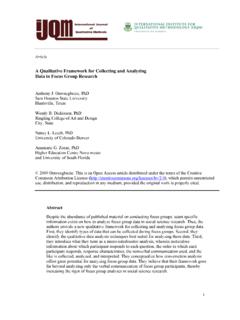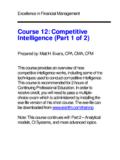Transcription of Collecting Weather Data - Virginia Department of …
1 Science Enhanced Scope and Sequence Grade 2. Collecting Weather data Strand Interrelationships in Earth/Space Systems Topic Weather data collection and interpretation Primary SOL The student will investigate and understand basic types, changes, and patterns of Weather . Key concepts include b) the uses and importance of measuring, recording, and interpreting Weather data ;. c) the uses and importance of tracking Weather data over time. Related SOL The student will demonstrate an understanding of scientific reasoning, logic, and the nature of science by planning and conducting investigations in which a) observations and predictions are made and questions are formed.
2 C) observations are repeated to ensure accuracy;. e) length, volume, mass, and temperature are measured in metric units and standard English units using the proper tools;. g) conditions that influence a change are identified and inferences are made;. h) data are collected and recorded, and bar graphs are constructed using numbered axes;. m) current applications are used to reinforce science concepts. Background Information Weather is the condition of the atmosphere at a given time. Many factors contribute to Weather , such as: Temperature: Temperature is a physical property of matter that quantitatively expresses the common notions of hot and cold.
3 Relative humidity: The amount of moisture in the atmosphere compared to how much moisture the air can hold at a specific temperature. Wind speed and direction: Wind is moving air that moves from hot to cold and from high to low pressure. Precipitation: Rain, snow, sleet, and hail are forms of precipitation that come from clouds. Cloud type and cover: Clouds are formed when water evaporates from oceans, lakes, and ponds and rises up into colder areas of the atmosphere due to convective or frontal lifting. The water vapor attaches itself to condensation nuclei which could be anything from dust or other tiny particles such as salt or other debris.
4 Once the vapor has been cooled to saturation, water condenses and the cloud becomes visible. A simple classification of clouds divides them into three general categories. These have names based upon the Latin root words that refer to the process of formation and physical structure of the clouds. The first of the three is the cirrus cloud. It is formed at high Virginia Department of education 2012 1. Science Enhanced Scope and Sequence Grade 2. altitudes and occurs mostly in the form of filaments (mare's tail). The next is the stratus cloud, which is mostly sheet-like in structure.
5 The third is the cumulus group, which appears heaped, rolled, and/or rippled. Second grade concentrates on basic Weather observations such as air temperature, precipitation and wind speed. Weather symbols are used on Weather maps as shorthand by meteorologists. There are standard Weather symbols that are used around the world. They help meteorologists communicate with other meteorologists about the Weather . Materials Weather journals that include Weather data collection sheets and prelabeled graphs (sample pages found at the end of the lesson).
6 A demonstration thermometer if available Thermometers (Celsius and Fahrenheit). Rain gauge: to make use a plastic water bottle, marbles or pebbles for in the bottom, permanent marker, and stake to attach the rain gauge to. Anemometer Weather vane: index card, straw, cardboard paper plate (not a waxed surface), drink cup with a lid from a fast food restaurant, glue, pencil with an eraser, straight pin Bubble solution (8 cups of water, cup liquid dishwashing detergent, 3 tsp. light corn syrup or glycerine). Paper cups and bubble wands Laminated Weather calendar and Weather symbols Chart paper and marker for graph of daily Weather types Six column chart for each month to build a month graph of the kinds of Weather experienced that month the class version of this chart can be built using chart paper and adding the large symbols found at the end of this lesson Copy of the student version of the six-column chart for each student Compass Virginia Department of education 2012 2.
7 Science Enhanced Scope and Sequence Grade 2. Vocabulary clouds, cold, cool, degrees Celsius, degrees Fahrenheit, freezing, hot, meteorologist, monitor, overcast, partly cloudy, rain gauge, rainy, snowy, sunny, symbol, temperature, thermometer, tool, warm, Weather , Weather instrument Student/Teacher Actions (what students and teachers should be doing to facilitate learning). Lesson Preparations Before you begin Weather data collection, make sure that you have all the needed Weather data collection tools in place. You will need a Celsius thermometer, a Fahrenheit thermometer, a rain gauge, an anemometer, and a Weather vane.
8 You may include other Weather data collection tools if they are available. If you do not have the rain gauge or the Weather vane, directions to construct them follow. (If desired, you can also have your students build their own rain gauges and Weather vanes to take home.) Instruct students on the purpose and the use of each Weather data collection tool before you begin the Weather data collection. 1. Precipitation Explorations a. Rain Gauge: You can make a rain gauge out of a plastic water bottle. 1. Remove the cap. 2. Cut the top off the bottle and invert the top into the bottle.
9 3. Put marbles or pebbles in the bottom if the bottom is not flat. 4. Measure and put a mark at each inch going up the bottle. Be sure to use a permanent magic marker. 5. Attach the rain gauge to a stake. 6. Plan to place the rain gauge in an area of the schoolyard where it is away from trees and building roofs, but is still accessible to your students. b. When you are ready to use the rain gauge, instruct the students on its use. 1. Call students to the rug. Ask: What kind of Weather do clouds sometimes bring with them? What do the clouds look like when there is rain?
10 2. Tell students that sometimes clouds bring more rain or snow than at other times. Show the students the rain gauge. Ask: How do you think a rain gauge works? Point out the measuring lines on the gauge. Explain, if needed, that the rain gauge collects falling rain. As more rain falls, the water level increases. The scale on the gauge shows the amount of rain that has fallen. 3. Tell the students that the class meteorologist will put the rain gauge outside if he or she thinks it might rain. After the rain event the class meteorologist will bring the rain gauge in to show the class.
















